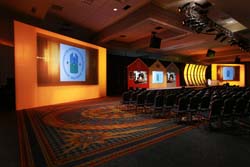- The 2006 National Fair Housing Policy Conference, a forum on successful strategies for enforcing fair housing and fair lending practices held in Anaheim, CA, yielded a dazzling display powered by Vista System's Spyder. With the theme "Fair Housing, It's Not an Option; It's the Law," the conference, sponsored by the U.S. Department of Housing and Urban Development's (HUD's) Office of Fair Housing and Equal Opportunity, drew approximately 900 attendees from across the nation.
The Dixon Group, Inc. (DGI), an event-planning firm based in Washington, D.C., teamed with Multi Media Presentation Group, a Vista, CA, staging company that recently went bicoastal with its new office in Orlando, FL. Primarily a high-end event provider, Multi Media Presentation hasn't worked with hotels or done street rentals for its seventeen years, focusing instead on its clientele of Fortune 1000 companies. Multimedia Presentation Group was charged with furnishing AV support in the main ballroom for all of the plenary sessions of the conference.
Five screens were constructed that could be switched independently of one another. The widescreen 16 x 9 foot letterbox format was used on the two outer main screens with live open captioning. Three smaller screens were built into houses as part of the stage set. Playback sources were four DVD players, DV Cam and Beta SP, three Sony D35 cameras, IMAG, PowerPoint, six computers and a character generator. Projectors were Christie Roadie 16K for the outboard screens and 6K for the center screens.
Multimedia Presentation Group deployed two Spyder 344 systems networked to the same router to provide a mosaic of pictures for the screens along with content and other graphics.
Executive VP and general manger Jim Bartolomucci of Multi Media Presentations noted, "Something unique about the setup was that we were routing IMAG, video, and open captioning live, which is one of the disabled requirements you run into at federal government shows. We were distributing with two spyder boxes while running CC live and recording it to tape as well."
"We ran the three independent screens off of one Spyder and the main screens off the second Spyder," explains Multimedia Presentation Group's Spyder programmer/operator Frank Musgrove. "The main screens were very programming-specific with image and playback graphics pertinent to speakers and presentations: They could show background graphics with PowerPoint, closed captioning and a keyed out logo. The main screens had four layers and the unique option of captioning over everything." The independent screens featured a variety of images and graphics related to the overall conference.
Cost Effectiveness Wins Out
Bartolomucci explained the choice of working with the Spyders, "We chose the Spyders because of the wide screen nature of the outboard screens and the complexity of the images going on them. They also gave the technical basis to run close captioning live. Most of those CC boxes are not show video friendly, but we worked with the manufacturer of the system to get it to stick to tape and run in the lower third of the screens. And the number of changes and displays on the house screens made it very cost effective to use the Spyders."
Ninety percent of the Spyder images were preprogrammed before the show. Musgrove said, "We programmed the Spyders with ease, and captured looks as they were onscreen, saving them for later recall in the middle of the presentation. Although both Spyders were independent they communicated via IP recalls which allowed me to run all of the screens off the main screen computer."
Spyder offers flexibility for mixing sources in multiple windows, greater clarity of signal processing, seamless widescreen displays plus real-time compositing for high-resolution applications in a modular, scaleable package. Users can deploy Spyder products alone or combine them like building blocks to accommodate any application from a small plasma screen to multiple screens. Spyder offers aluminance keyer and color keyer on every input. They support up to 32 independent windows, or up to 16 mixers. All Spyder inputs allow any input to operate as native high-resolution channels, scaled PIP, scaled background, or key channels. Spyder Inputs can also be switched from any of the modes during normal operation. Resolution independence allows multiple projectors to be used to increase pixel space and increase resolution beyond what any single display device can handle.
Any output can be an operators monitor, displaying preview and program for a given pixel space simultaneously on a single output. It provides a fully integrated test pattern generator on each input, output and pixel space, as well as powerful frame stacking capability, with the expansion option, that allows inputs/outputs from other Spyder systems to contribute/view a single pixel space.










